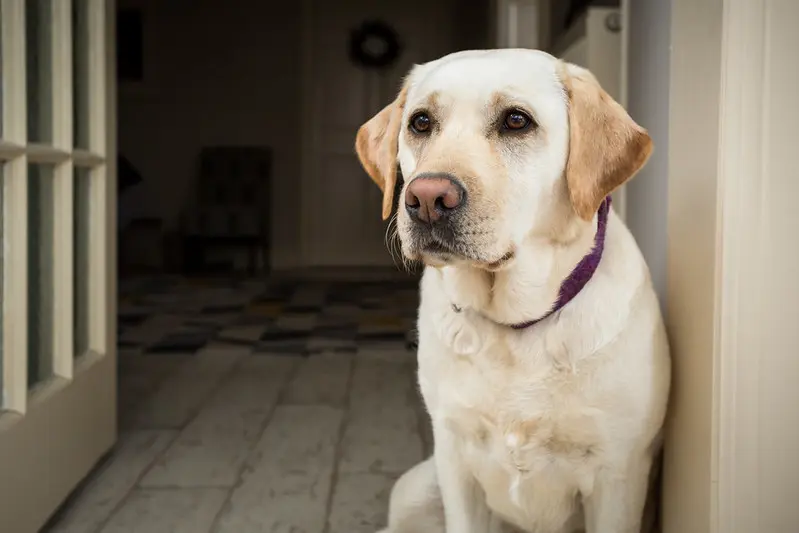Separation anxiety
Dogs may suffer from separation anxiety when they are left alone. They may bark, chew, become destructive, scavenge, or toilet as a result. A dog of any age can suffer from separation anxiety; it is something that can develop over time, happen quickly after a bad experience, or be present from a young age. Certain breeds and temperaments can also be more prone to separation anxiety, due to their desire to be close to people.

Puppies who have recently joined their new family are likely to bark, whine and toilet overnight. They are usually used to sleeping with their litter mates, therefore being alone in a completely new environment is very unnerving for them.
In order for your dog to be comfortable being left on their own, they need to be taught and introduced to this gradually and positively. The plan below is designed to be carried out over a series of weeks (or months in some cases) and progress at your dog’s pace.
How to teach your dog to be alone
Step 1
Make sure you have a safe space set up, usually a crate for puppies but you may have a room with a baby gate or a secure area (see Using a puppy crate).
Teach your dog that being in their safe space is a positive experience. Place a treat in there to encourage them in; if they go in there on their own accord, again reward them. Feed them in the safe space, put their toys in it during the day, and provide a selection of chews in there as well.
Once a day place a tasty filled KONG (or other high value, long-lasting chew) in there to chew on, with you in close proximity. If they are happy to settle in their safe space with the treat and are not avoiding it in any way, then you are ready to move onto the next step. (One sign of stress in dogs is avoiding or ignoring food – if your dog seems disinterested in their chew, this may indicate that you both need to progress more slowly).
Step 2
Once your dog is confident with having a chew in their safe space while you walk about, perhaps even when making a cup of tea, provide your dog with something even tastier, e.g. a filled KONG with extra high value filling to keep them occupied while you go about your usual business around the house.
It’s helpful if you provide them with a visual cue (that only comes out during the sessions), such as a special blanket or towel to lay on their bed- this will become the signal of “when this blanket/towel is here, I am left to chew and doze”.
Step 3
Make sure that you have positive practice sessions each day with your dog having a nice chew in their safe space. Start to build into this all of the steps that you take when you leave them, e.g. putting your coat on, putting your shoes on, picking up keys, turning lights off, closing curtains etc.
KONGs should be safe to leave with them unsupervised. If you are worried that all the extra food will cause them to need the toilet, use something like soft cheese or xylitol-free peanut butter spread around the inside- freezing them can make them last longer.
Step 4
Bringing this together, still using their designated mat/blanket, you will end up with sitting in the room with your dog (but not interacting with them), picking up your keys, putting your shoes on, wondering in and out etc. with them happily enjoying their chew on their bed. If you are using a crate or baby gate etc. start to shut the door for only a few seconds to begin with and building this time up so that it is left shut for 1 minute, 5 minutes, 10 minutes, 20 minutes, and so on.
If your dog gets distressed at all, go back to the last step where they were calm and comfortable. You can then progress to walking out the front door, going upstairs etc., again gradually building up time that they are left alone in their area from 1 minute, to 5 minutes, 10 minutes, 20 minutes and so on.
Each time, once the session is over, remove the blanket/towel and give your dog some calm positive attention if they desire it. If your dog usually toilets when they are left alone, place them into the garden/toileting area to make sure they have ample opportunity to go.
If all is going well, start to leave your dog on a daily basis – whether you are actually going out or not (you can also go out to sit in the car to make a phone call or answer emails) – so that it becomes part of daily routine rather than an intermittent distressing event. After sufficient exercise and/or mental stimulation, encourage them to settle in their safe space with their visual signal (blanket/towel) and KONG/favourite chew item.
Long term plan
Whenever you leave the house, always ensure your interactions are kept calm and relaxed. Settle them into their safe space 20 minutes before you are due to leave. Don’t interact with them for this period and leave the room quietly whilst they are busy with their chew or quietly dozing in their bed. On returning to them, again keep interaction relaxed and calm, and reward/make a fuss of them once they have settled.
During the day
The more opportunities your dog has to settle away from you during the day, the less intense their anxiety will be when being left. While they are learning, there will obviously be times when you need to leave them. Try to make the experience as positive as possible, using the techniques of settling them in first and using a stuffed KONG or a nice chew knowing that you are working on teaching them gradually and positively, outside of the situation.
Even if the problem is resolved, keep up this teaching every now and again, and when leaving them in the day, leave them with a tasty KONG.
During the night
While the dog is still not confident to be on their own, we don’t suggest leaving them on their own overnight. Placing the crate in the bedroom, close to your bed so you can reach out and comfort them even while crated, helps make the nights easier for both the dog and the family. Slowly you will be able to move the crate away from you and eventually to another room.
Keep up the good work
We suggest building up your dog’s overall confidence. Once they stop following you around and start to choose to wander away from you, e.g. to explore the garden on their own or stay in a room while you go into another, you will know that your dog is growing in confidence. In these situations and throughout the whole process, reinforce them with calm, quiet praise. They often pick up on our own emotions, so it is important to try and stay calm ourselves as well.
Please note that your dog should never be left for more than 4 hours on their own, and considerably less for a puppy and/or if in a crate.
Help support our life-changing work...
Imagine if everyday tasks were so challenging or physically demanding they affected your quality of life. For many people living with a disability of families with a child with autism, that is their reality. Now imagine if a specially trained four-legged friend could restore your, or your family’s, independence.
The demand for our services is high and we can’t help as many people as we would like to without more funding. Please help us continue making life-changing differences for people with disabilities through the power of expertly trained dogs.
Every contribution, whatever size, is important and helps us make a difference.

